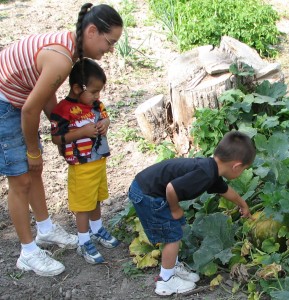NCFL and the FACE Program Celebrate 25 Years | Part 2
By Margo Waddell
 In 1990, the Office of Indian Education Programs (OIEP), now the Bureau of Indian Education (BIE), developed a groundbreaking early childhood/parental involvement program in BIE schools called Families and Child Education (FACE). Now in its 25th year, the national partnership between BIE, Parents as Teachers National Center (PAT), and NCFL is still going strong. During this time period, FACE has been implemented in 57 schools in 12 states, and has served approximately 36,000 American Indians, including 17,000 adults and 19,000 children in approximately 14,500 families. FACE exists today in 43 programs in 10 states.
In 1990, the Office of Indian Education Programs (OIEP), now the Bureau of Indian Education (BIE), developed a groundbreaking early childhood/parental involvement program in BIE schools called Families and Child Education (FACE). Now in its 25th year, the national partnership between BIE, Parents as Teachers National Center (PAT), and NCFL is still going strong. During this time period, FACE has been implemented in 57 schools in 12 states, and has served approximately 36,000 American Indians, including 17,000 adults and 19,000 children in approximately 14,500 families. FACE exists today in 43 programs in 10 states.
The program was designed to provide culturally and linguistically responsive education, resources and support for American Indian/Native American families with children from birth to grade three. FACE is a comprehensive early childhood family literacy program that includes: home-visiting; preschool education; adult education; and an intensive parent engagement component. Outcomes over the years include: improved academic performance for students and parents, decreases in the need for special education services, increased parent self-efficacy, and increased employment rates.
 The numbers are one side of the story. The other side of the story is about the experience of families participating in FACE. One such story in stands out in particular as I look back over the past 25 years:
The numbers are one side of the story. The other side of the story is about the experience of families participating in FACE. One such story in stands out in particular as I look back over the past 25 years:
I first met Jake when I made a FACE visit early in the school year to a geographically isolated Ojibwe school in Minnesota. Jake had just turned three years old when I met him on the carpet in the block area of the classroom reaching for a truck. He was unable to move forward to get the truck on his own. He was born with severe spina bifida. I reached down and rolled the truck close enough for him to successfully grasp it. His broad smile warmed my heart. I asked the staff how we could help this child have greater mobility within the class—knowing full well this was going to be a tough process. I encouraged the teachers to work with their local health services and the family to see what accommodations were available.
 A year later I returned to the school and found Jake had been given a new freedom to explore his environment. A “scoot cart” had been designed for him with swivel wheels that he could be strapped to and move independently throughout the room. He seemed to recognize me as I came over to the block area where he was playing. I said, “Hi Jake, what are you doing?” He grinned broadly and said, “driving.”
A year later I returned to the school and found Jake had been given a new freedom to explore his environment. A “scoot cart” had been designed for him with swivel wheels that he could be strapped to and move independently throughout the room. He seemed to recognize me as I came over to the block area where he was playing. I said, “Hi Jake, what are you doing?” He grinned broadly and said, “driving.”
What I learned from Jake as he progressed through the FACE program was that no matter what his physical challenges were, his determination and cognitive abilities were what his family and educators were most focused on. Indeed, this is the essence of what FACE tries to accomplish for students like Jake every day. He participated in all of the activities in the class, just from a different vantage point—and his peers also encouraged him to join the fun.
FACE provides equal opportunities for all children through family, school, and community partnerships. The success of FACE reminds us that there are ways to rise above the boundaries of poverty.
Here’s to another 25 years!
This post is the second of a two-part reflection on 25 years of the FACE program. Margo Waddell is NCFL’s director of Family and Child Education (FACE). Read NCFL President and Founder Sharon Darling’s reflections on 25 years of working with the Bureau of Indian Education, Bill Mehojah, and Parents as Teachers here.